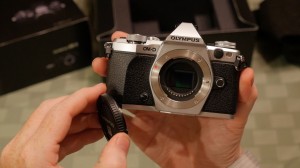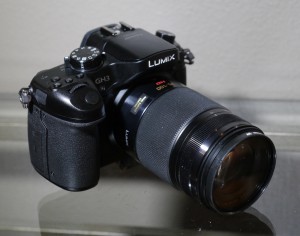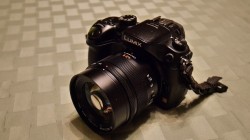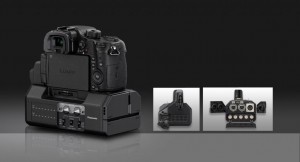

I was the National Association of Broadcasters (NAB) 2017 for the Online Filmmakers Forum and YouTube channel Personal-View.com.
The following is a playlist of the interviews I did at the booths for them.



I was the National Association of Broadcasters (NAB) 2017 for the Online Filmmakers Forum and YouTube channel Personal-View.com.
The following is a playlist of the interviews I did at the booths for them.

 Saturday was the Kenmore Camera Anniversary Sale. Olympus was on hand with the new Olympus OM-D E-M5 Mark II. As turns out, they supplied Kenmore with some of the first cameras in the country. The official release date I was told was Feb. 27th. I bought one after putting it through it's paces in the store. I took it home with me and opened the box and this is what I found.
Saturday was the Kenmore Camera Anniversary Sale. Olympus was on hand with the new Olympus OM-D E-M5 Mark II. As turns out, they supplied Kenmore with some of the first cameras in the country. The official release date I was told was Feb. 27th. I bought one after putting it through it's paces in the store. I took it home with me and opened the box and this is what I found.

Sorry for being away for so long. I had a very busy fall.
A new important firmware update is available today from Panasonic. It address a problem that has had many owners unhappy. Some have returned the lens. I like my lens, but have noticed the micro-jitters people are complaining about. I even tested another lens at Kenmore Camera.
The new firmware update for the Panasonic Lumix G X 35-100mm F2.8 O.I.S lens improves the stability of O.I.S (Optical Image Stabilizer) in Motion Picture recording. An important update when using Panasonic DMC-GH3 and the 4K video recording DMC-GH4 mirrorless models.
Details are at Panasonic support page.
The Panasonic H-HS35100 35-100mm f/2.8 lens has construction including 18 elements / 13 groups of optical elements crafted from Ultra Extra-Low Dispersion (UED) and Extra-Low Dispersion (ED) glass, and uses Panasonic’s Nano Surface Coating to minimize internal reflections and flare.
My verdict: A definite improvement. I have not used this lens as much as would have liked but now I will use it more.

What is big, heavy, bright, all mental and is the most expensive Lens that I have ever bought? Enter the Panasonic Leica DG Nocticron 42.5mm F1.2 A.S.P.H. Power O.I.S. Lumix G. I recently paid a visit to Kenmore Camera and made a big dent in my wallet. That is a lot of words describing an amazing lens. This is the most robust, built like a tank lens that Panasonic has ever created. It looks and feels – Leica, and is priced so accordingly. This lens is not for everybody but will be used by those who appreciate its unique characteristics. Micro Four Thirds finally has a lens that competes directly with larger sensor cameras and has that low focus plane with that pleasing out of focus background.
Here are some photo samples of this lens.
The video I have created is just to give you a first look at this new lens for Micro Four Thirds. A review will follow later.

4K – it is insane. I cannot even play it back on the screen of late 2013 MacBook Pro Retina. 4K video has more pixels than my screen so I cannot view it in all it's grandeur. I have posted on YouTube at 4K the footage I shot at Kenmore Camera’s Grand Opening on a preproduction GH4. For those of you can view 4K it is there for you to see. The rest of us Will have to view it at lower resolutions.
The GH4 is the first camera that I will own that has more resolution than my computer screen. I have experienced 4K video before using a RED camera. The RED camera files were difficult to use because that camera only shoots RAW so the file sizes are huge.
At 100 Mb per second the GH4 files are much more easy to use. I like that the h264 files are in a QuickTime wrapper in the camera. I had no real trouble editing this footage. Final Cut Pro X is already set for 4K. Your performance on another editor may very. I imported the footage from the SD card and it did not take that long because the file sizes are reasonable. FCPX has smooth playback while editing this footage. I did not add a lot of effects or layers so rendering times were quick. Later I will do some heavier editing to push my editor to see if I have any problems.
Shooting with the GH4 requires a very fast SD card to have the camera continue recording without stopping. It appears that 95 Mb per second cards seem to keep up with the 4K video. These faster cards also make importing the footage faster.
Also I will post some 4K screen grabs from the 4K video in my Flickr Set.

The rumored GH4 has been introduced by Panasonic. The Lumix GH4 is a 16.05-megapixel micro four thirds camera whose standout feature is the ability to shoot 4K video footage. The GH4 can shoot 4K at 30/25/24fps at 100Mbps using IPB compression. At 1080p that rises way beyond broadcast standard to ALL-Intra 200Mbps. All this to a SDHC card
It also has much to offer still photographers too. It does this thanks to its brand new 16.05MP Live MOS sensor and latest quad-core Venus Engine IX which is much more powerful than before. It’s this one feature that really sets the GH4 apart from the earlier GH3. To look at from the front it’s nigh on impossible to tell the two apart – there’s the same weather-sealed magnesium body and layout, only there’s a lock on the main mode dial and flipping the body around also reveals a new larger eyecup around the viewfinder. The shutter unit allows a max. 1/8000 shutter release and is also redesigned to be even more durable for approx. 200,000 actuations.
– New 16.05 Micro Four Thirds sensor
– 4K Video output in MOV or MP4.
– 4K from a nearly full pixel readout of the sensor, internal recording
– Resolution is 3840 x 2160 (1.85:1) or 4096 x 2160 16×9.
– 1 hour of 4K footage will take up around 45 GB
– 100mb/s (4K) or 200mb/s All-I (1080) video recording
– 96fps slow-motion at 1080p
– 4:2:0 to the SD card, 4:2:2 otherwise
– NFC, Wifi capabilities
– 1/8000 shutter speed
– 200,000 actuations shutter
– 1,040k Dot 3-inch OLED panel
– 2360K Dot OLED viewfinder
– Splash and dust proof with a magnesium alloy body
– new quad-core processor Venus 9 engine
– Contrast AF and a new focusing type called DFD.
– Zebras and focus peaking
– Improved AF in low light
– New 49-point array autofocus system (GH3 23-point system)
– Bulb mode of up to 60 mins
– FHD 60P readout
– 12fps burst shooting
– 7.5fps while in continuous autofocus
– 4 socket HD-SDI output
– 2 XLR input
– Full size HDMI output
– 12 volts XLR power
– 4K and HD at 4:2:2 chroma subsampling and 10-bit color
Movie shooting options (MOV or MP4 wrapper)
4K (3840 x 2160)
29.97p 100Mbps (IPB) Linear PCM/AAC
23.98p 100Mbps (IPB) Linear PCM
Full HD (1920 x 1080)
59.94p
200Mbps (All-I) Linear PCM
100Mbps (IPB) Linear PCM
50Mbps (IPB) Linear PCM
29.97p
200Mbps (All-I) Linear PCM
100Mbps (IPB) Linear PCM
50Mbps (IPB) Linear PCM
23.98p
200Mbps (All-I) Linear PCM
100Mbps (IPB) Linear PCM
50Mbps (IPB) Linear PCM
24.00Hz Cinema
4K (4096 x 2160) 24p 100Mbps (IPB) Linear PCM
4K (3840 x 2160) 24p 100Mbps (IPB) Linear PCM
Full HD (1920 x 1080) 24p
200Mbps (All-I) Linear PCM
100Mbps (IPB) Linear PCM
50Mbps (IPB) Linear PCM
AVCHD shooting options

Full HD (1920 x 1080)
59.94p 28Mbps (IPB) AAC
29.97p 24Mbps (IPB) AAC
23.98p 24Mbps (IPB) AAC
Press Release:
The Panasonic LUMIX GH4 DSLM (Digital Single Lens Mirrorless) Camera is the World’s First* DSLM with 4K Video Recording Capability
Designed To Meet Professional Needs for Both Still and Video Capture
Panasonic is proud to introduce the ultimate still/video Digital Single Lens Mirrorless (DSLM) camera for both photographers and cinematographers alike. The Panasonic LUMIX DMC-GH4 (GH4) is the world’s first DSLM with 4K cinematic recording capability. The image quality for both still and video is dramatically improved by Panasonic’s cutting-edge technologies.
The newly developed 16.05-megapixel Digital Live MOS Sensor for the GH4 excels both in sensitivity and response and suppresses rolling shutter effect even when using the electronic shutter. The Venus Engine image processor has been newly developed dramatically boosting its performance with a new quad-core CPU that allows high speed signal processing that is required for rich 4K video recording. Integrating superior noise reduction systems, the GH4 enables shooting at maximum ISO 25,600. Sensitivity, gradation performance, resolution and color reproduction are dramatically improved to achieve even higher picture quality. The GH4 boasts high speed burst shooting at 12 frames per second (AFS) up to approx.40 (including RAW) / approx.100 (excluding RAW) and 7.0 fps(AFC) to capture fast moving subjects.
The new GH4 has evolved into a professional video camera. One of the most prominent advances is unlimited 4K video recording (Cinema 4K: 4096×2160 / 24 fps and QFHD 4K: 3840×2160 / up to 30 fps) in MOV/MP4*2. The GH4 is also capable of recording Full- HD video with ultra high bit rate at 200 Mbps (ALL-Intra) or 100 Mbps (IPB) without recording time limit*2. Users can freely choose the format from MOV, MP4, AVCHD Progressive and AVCHD at a variety of frame rates according to the usage. For professionals working globally, the system frequency can be easily selected between 59.94Hz (23.98Hz) / 50.00Hz / 24.00Hz. The GH4 is also capable of real-time image output to an external monitor via an optional micro HDMI cable simultaneously while recording video. For more unique video expression, VFR(Variable Frame Rate) or Time Lapse/Stop Motion Animation can be produced with GH4 without postproduction processing. In addition, a variety of practical functions required for professional video recording are newly integrated.
The high-precision Contrast AF system in the GH4 is further enhanced by Panasonic’s integration of DFD (Depth from Defocus) technology which shortens the time to focus to achieve ultra high speed AF of approx.0.07 sec*3. Not only speed but also the operability is enhanced thanks to the addition of Face / Eye Detection AF or 49-point AF with Custom Multi AF mode.
The GH4 boasts newly developed high-precision, high-speed dual OLED (Organic Light-Emitting Diode) displays of 2,359K-dot LVF (Live View Finder) and 1,036K-dot rear monitor. Both the LVF and rear monitor adopt an OLED to achieve high speed response with minimum time lag while enhancing the resolution. Notably, the OLED for the LVF in GH4 boasts 10,000:1 high contrast for superior color reproduction.
To be tough enough to withstand heavy field use, the main structure of the GH4 is composed of a magnesium alloy full die cast front/rear frame. It also features splash / dustproof construction by sealing every joint, dial, and button. The shutter unit allows a max. 1/8000 shutter release and is also redesigned to be even more durable for approx. 200,000 actuations.*4
1. The World’s First Digital Single Lens Mirrorless (DSLM) Camera Recording High Quality Video in 4K – To Meet Professional Quality and Standards
One of the most prominent advances is unlimited*1 4K video recording (Cinema 4K: 4096×2160 / 24 fps and QFHD 4K: 3840×2160 / up to 30 fps) in MOV/MP4*2. The GH4 is also capable of Full-HD video with ultra high bit rate at 200 Mbps (ALL-Intra) or 100 Mbps (IPB), which does not have limit of recording time. Users can freely choose the format from MOV, MP4, AVCHD Progressive and AVCHD at a variety of frame rates according to the usage. In MP4 / MOV, high quality sound in LPCM (Linear Pulse Code Modulation) is recordable.
The GH4 is also capable of real-time image output to an external monitor in 4:2:2 / 8-bit*5 via an optional micro HDMI cable simultaneously while recording video. Even 4:2:2 / 10-bit is available which is suitable for the professional requiring serious monitoring of the footage. Users can choose to output only the recording content or the content with the menus individually depending on a display.
Plus, the VFR (Variable Frame Rate) enables recording video with slow/fast motion such as 96 fps, 4x, all in Full-HD*6. Time Lapse / Stop Motion Animation video can be produced in camera, too.
For more precise control over video image quality, the GH4 integrates Zebra Pattern to prevent white wash-out and Focus Peaking to aid with manual focusing. The GH4 even offers a Master Pedestal Adjustment with 15 steps. Gamma presets exclusively for video recording are now available in Creative Video mode – “CINELIKE D” and “CINELIKE V” for rich video expression. Synchro Scan mode is also newly available to reduce and suppress flicker. It is possible to display a Center Marker while recording.
The GH4 is equipped with functions that meet global standard for synchronous video recording. A 1KHz Test Tone and Color Bars (SMPTE / EBU / ARIB Standard) are available on the GH4. The camera also embeds SMPTE-compliant Time Code either in Rec Run or Free Run count-up methods, which makes it easy to synchronize the multiple video footage or sound source in the post production workflow. Time Code Value can be started at any point of [Reset], [Manual Input] and [Current Time]. Drop frame or Non Drop Frame time code is selectable*7. When recording the video in MOV, AVCHD Progressive, AVCHD or MP4 (LPCM), the GH4 automatically generates multiple seamless files for continuous recording. During playback, the AVCHD Progressive / AVCHD files are reproduced with seamless, interruption-free continuity.
A total of 22 LUMIX G digital interchangeable lenses offer any creative perspective according to the scene, including HD lenses allowing silent, high performance AF control suitable for video recording.
2. The Newly Developed 16.05-Megapixel Digital Live MOS Sensor and Venus Engine Achieving High Speed, High Sensitivity Image Recording
Panasonic developed a new 16.05-megapixel Digital Live MOS Sensor for the GH4 that achieves high quality, high sensitivity image recording with quick response. Approx. 50% higher speed signal readout suppresses rolling shutter effect even when using an electronic shutter or recording video. Taking full advantage of the Live MOS Sensor, dynamic range is expanded by max.1/3 stop at low ISO sensitivity.
The Venus Engine image processor is newly developed boosting its performance with a quad-core CPU that lets high speed signal processing required for rich video recording such as 4K. The advanced Multi-process NR (Noise Reduction) applies effective noise reduction and edge processing according to each component frequency. Plus, a newly added Random Filter granulates chromatic noise to be blended into the image even more naturally. As a result, a max. ISO 25,600 has been achieved. On the other hand, optimizing the combination design of new sensor, new imaging engine and low pass filter enhances the limit resolution by more than 5% while suppressing moire. A newly adopted aperture filter is capable of controlling over a wider frequency range. It adjusts the amount of sharpness according to the frequency level, resulting in faithful stereoscopic effect. The Venus Engine also improves color reproduction with accurate evaluation of each color even if it is similar not only in color phase but also in saturation and luminosity.
3. High Speed Response Required for Professionals and Practical AF Options
All LUMIX G cameras use the Contrast AF for its focusing system. Compared with the Phase difference system AF, the Contrast AF boasts higher accuracy especially in shooting with a bright lens with a small F value. With a LUMIX G digital interchangeable lens capable of digital signal exchange at max. 240 fps, the focusing is stunningly quick and smooth. The Contrast AF system in the GH4 is further enhanced by Panasonic’s integration of DFD (Depth from Defocus) technology which even shortens the time to set focus. It calculates the distance to the subject by evaluating 2 images with different sharpness level while consulting the data of optical characteristics of the current lens. As a result, the GH4 achieves ultra high speed AF of approx.0.07 sec*8. This improvement benefits more as focusing distance increases. The burst speed of shooting is dramatically faster than its predecessor, the DMC-GH3, boasting high speed burst shooting at 12 fps (AFS) up to approx.40 (including RAW) / approx.100 (excluding RAW) and 7.0 fps (AFC) to capture fast moving subjects in-focus.
In addition, the stability of continuous focusing is improved by minimizing wobbling in both still and video recording. Together with the quick start-up and short release time lag, the GH4 never lets photographers miss fleeting shooting opportunities.
The GH4 incorporates Eye Detection AF which automatically sets focus right on the eye of human face. Focus point is increased from 23 (GH3) to 49 points for more flexible composition together with Custom Multi mode in which users can freely select the blocks needed to focus out of the 49 points. Now the 1-area AF area can be seamlessly magnified not only in manual but also in auto focus mode. Tracking AF is also advanced in the point of tracking accuracy by estimating the subject’s movement. Focus point can be set on any part of the 100% field of view. The time to show magnified image can be selectable in Pin-point AF. Focus point can be magnified either with the MF ring or with cursor key in MF Assist mode. In the Touch Pad AF, the position can be set either on absolute/relative coordinate. Together with the Eye Sensor AF which starts focusing by just looking into the viewfinder, the AF/AE lock button works for AF for quick auto focusing even when using the LVF.
4. Stunning Mobility Supported by Mechanical Advancements
The GH4 boasts newly developed high-precision, high-speed dual OLED (Organic Light-Emitting Diode) displays for LVF (Live View Finder) and rear monitor. Increasing the resolution of display area to 2,359K-dot, the new 16:9 Wide Screen LVF boasts approx.1.34x / 0.67x (35mm camera equiv.) magnification and 100% field of view and eye point of approximately 21 mm. Thanks to the newly designed large eyecup, the visibility of LVF is dramatically improved. The image output between the LVF and the rear monitor is switched automatically with the eye sensor on the LVF, which features options of sensitivity – high, low and off – to reduce false operation during touching on the rear monitor. The 3.0-inch 1,036K-dot free-angle OLED rear monitor (3:2 aspect) with wide-viewing angle rotates 180° to the side and tilts 270° up and down offers approx. 100% of field of view. This rear monitor adopts static touch control for more smooth operation either in shooting or in playback. Both LVF and rear monitor adopted OLED to achieve high speed response with a minimum time lag while enhancing the resolution. Notably, the OLED for the LVF in GH4 boasts 10,000:1 high contrast for superior color reproduction. Now the excellent visibility comes closer to OVF. On the other hand, live view image can also be displayed in monochrome through the LVF enabling concentrating on contrast.
Even a moment’s waste matters in professional shooting, but it is possible to make target setting intuitively with the GH4. Three dials are equipped on the top and back of the camera and the main dial is now comes with a lock structure. A dedicated button allows direct reach to exposure compensation, white balance adjustment or ISO setting and max.5 settings can be assigned to the Fn button. All these external components are designed to be operated easily without taking eyes off the viewfinder.
Both built-in/external flash can be synchronized with max.1/250 second shutter speed.
5. Expandability for A Variety of Workflows
Easy Wireless Connectivity via Wi-Fi® / NFC with Smartphones
The GH4 integrates Wi-Fi® connectivity (IEEE 802.11 b/g/n) with NFC (Near Field Communication) technology camera to offer a more flexible shooting experience and instant image sharing with easy operation. With the Panasonic “Image App”, remote shooting of both photo and video is available by using the smartphone/tablet as a remote shutter with a monitor. Not only releasing the shutter, but zooming, focusing and settings of shutter speed, aperture, exposure compensation are all controllable with a smartphone / tablet. All these flexible shooting / browsing / sharing styles are made possible with the GH4 and the Panasonic's dedicated application software, the Panasonic Image App for iOS / Android smartphones / tablets. It is also easy to embed geotags in the image after shooting. For the smartphone/tablet without NFC, the camera can display a dedicated QR code on its monitor to complete pairing easily by reading the code.
Output/Input Terminals
The GH4 comes with a variety of connection terminals for more flexible shooting options. The 3.5mm microphone jack is for high quality audio recording using an external microphone and the 3.5mm headphone jack which enables monitoring the audio while shooting video real-time. It is also capable of real-time image output on an external monitor via an optional HDMI micro cable simultaneously while recording video. In addition to these, the GH4 complies with AV outputs (Audio 2ch, Composite), flash sync terminal and 2.5mm jack for remote controller.
For reliable recording of rich video, the GH4 complies with UHS Speed Class 3 (U3) which is the new speed class standard of SD memory card. The UHS Speed Class 3 (U3) guarantees a constant minimum write speed of 30MB/s to respond to market needs for 4K video.
Optional Accessories
A GN58 is a powerful External Flash (DMW-FL580L) and is newly added to the LUMIX G optional accessories which allows high speed charging of approx.1.7 sec. Not only with wireless control but also LED video light function are available. The Stereo / Shotgun Microphone (DMW-MS2) which enables stereo/shotgun switch even allows more precise sound recording with selectable Super Shotgun / Lens Auto / Manual option on GH4.
6. Other Features
Luminance Level Adjustment
Just as the concept of “the ultimate hybrid DSLM camera” identifies, the GH4 supports smooth postproduction for photographers migrating to videography. In addition to the standard luminance level of 16-235*9 and 16-255*9, GH4 offers 0-255*9 which is equivalent to photo standard.
Focus Peaking
For more practical control over focusing, the GH4 incorporates Focus Peaking function that shows the peak of focus in MF and AF+MF mode. Users can see the peaking of focus while monitoring the subject in live view. It can be set to HIGH / LOW / OFF and the color can also be changed to blue, white or orange according to the color of the shooting scene during live view. Users can take advantage of this function when controlling the camera with a smartphone / tablet via Wi-Fi in both photo / video recording.
Silent Mode
This mode switches shutter from mechanical to electronic and turns all sound (AF, operation) off while suppressing the emission of the AF assist lamp and flash with just a single setting for special shooting occasions.
Highlight/Shadow Control
The Live View function is also advanced digitally making it possible to adjust highlight / shadow separately with the front/rear dial. Three patterns of settings can be customized in addition to the three presets.
RAW data development in Camera
The GH4 is capable of developing RAW images in camera. In addition to the color space setting ( sRGB / Adobe RGB ), the parameter of white balance, exposure compensation, contrast, highlight/shadow, saturation, noise reduction, sharpness or hue can be flexibly adjusted while LUMIX’s Photo Style, Intelligent D-range Control, Intelligent Resolution can also be applied.
Interface Unit (DMW-YAGH)
Panasonic offers an new optional Interface Unit (DMW-YAGH) exclusively for professional/industrial workflow with GH4 that enables more powerful video transmission. It complies with Full HD (4:2:2 / 10-bit) offering four parallel outputs and these can be used for 4K (4:2:2 / 10-bit) output – both with time code*10. The XLR input terminals (2ch) are also equipped to connect line or condenser microphone. When connecting with microphone, volume can be controlled for L and R separately, which can be monitored LED audio level display on the back of the unit. The 12V DC IN is highly compliant with large-capacity industrial battery and continuously supplies the GH4 with power*11.
Footnotes:
*For a digital single lens mirrorless camera as of February 7, 2014.
*2 Use SDXC/SDHC Memory Card compatible with UHS Speed Class 3 (U3) when using high bit rate video recording mode over 100 Mbps.
*3 In AFS, With LUMIX G VARIO 14-140mm / F3.5-5.6 ASPH. / POWER O.I.S. or LUMIX G X VARIO 12-35mm / F2.8 ASPH. / POWER O.I.S.
*4 Panasonic in-house testing.
*5 Setting the HDMI output picture quality
[4:2:2 10bit]:You can output the image through the HDMI connection in higher picture quality, but you cannot record it as a motion picture or still pictures. Ideal when the HDMI output is to be saved on external devices.
[4:2:2 8bit]:You can record the image while outputting it through the HDMI connection. Ideal for recording while checking the motion picture on an external monitor. When using 4:2:2 / 8-bit output, video is recorded in 4:2:0 / 8-bit on SDXC/SDHC Memory Card.
*6 In 24p playback. Effect value varies depending on the recording format and frequency.
*7 When system frequency [59.94Hz] is selected
*8 In AFS, With LUMIX G VARIO 14-140mm / F3.5-5.6 ASPH. / POWER O.I.S. or LUMIX G X VARIO 12-35mm / F2.8 ASPH. / POWER O.I.S.
*9 8-bit
*10 Setting the HDMI output picture quality [4:2:2 / 10bit]
You can output the image through the HDMI connection in higher picture quality, but you cannot record it as a motion picture or still pictures. Ideal when the HDMI output is to be saved on external devices. When using 4:2:2/10-bit output, simultaneous video recording on SDXC/SDHC Memory Card in the camera is not possible.
*11 HDMI output from the camera is not possible when the camera is mounted on the Interface Unit.
Here is video shot with the GH4.

 On this day of remembrance of the lives lost in Pearl Harbor I have a story to tell. As part of the coverage for AFL China was our visit to Honolulu for the first of 2 games being played by the AFL All-Stars. In preparations for the game on Dec 2nd in Honolulu, we traveled to historic sites. One of them being the Arizona Memorial in Pearl Harbor. A shot done with my GH3 was used in the video that evening.
On this day of remembrance of the lives lost in Pearl Harbor I have a story to tell. As part of the coverage for AFL China was our visit to Honolulu for the first of 2 games being played by the AFL All-Stars. In preparations for the game on Dec 2nd in Honolulu, we traveled to historic sites. One of them being the Arizona Memorial in Pearl Harbor. A shot done with my GH3 was used in the video that evening.
First of all I must warn you it is not as easy one might think to shoot there. When trying to enter the Memorial Site staging area on land before the boat takes you out to the actual memorial on the bay, the park ranger said that no backpacks (camera bags) were allowed on the grounds. So I had to take my bag back to the car. I put my extra lenses in my pants pocket. Shooting Micro Four Thirds has it's advantages. The lenses are small enough to do so. Try that with a C or N 70-200mm.
We were asked not to shoot video at the memorial and in respect to memorial I did not shoot any video at the site on the bay but did shoot from the boat going from it.
Here is the video used that evening at the AFL China site. For Lou's standup for the video we used my F&V R-300 LED ring lights, my GH3 and my new Manfrotto MVH500A tripod.

I have already written how I have converted to mirrorless. It is nice when others are realizing the same thing. A recent article on this is featured on Gizmodo called “The Last Days of the DSLR”. But, one of the points of this article misses the mark. The author seems to get excited by Sony's new entry – the A7.
 “The final step for mirrorless hegemony is tackling the high end. Sony will soon ship its milestone A7 series, two compact mirrorless bodies with full-frame sensors, the lynchpin of top-tier camera bodies and the harbingers of the DSLR's doom. They are, simply put, the best of both worlds.”
“The final step for mirrorless hegemony is tackling the high end. Sony will soon ship its milestone A7 series, two compact mirrorless bodies with full-frame sensors, the lynchpin of top-tier camera bodies and the harbingers of the DSLR's doom. They are, simply put, the best of both worlds.”
There is a big problem with full frame 35mm cameras, SLR or Mirrorless – the size and weight of the lenses. Physics is physics. Just because the body is smaller and lighter does not help with the lenses. It is a step in the right direction. You have a small camera with really big lenses. With the advance in technology, the full frame 35mm sensor is no longer necessary for low noise, high resolution photography.
To me the real advance in mirrorless cameras is small, light weight camera bodies with small, light weight lenses. By reducing the sensor size from the still full frame 35mm to the four thirds sensor, Panasonic and Olympus have been able to make a smaller and lighter over all camera. The 35mm motion picture frame size has been a standard for over a 100 years and the Micro Four Thirds sensor is almost as big. Still full frame was invented out of the motion picture size by turning the film sideways from vertical to horizontal. With M43rd's, we are just now going back to the original size.
I will put Panasonic's GH3 against any other manufacture's “Top Tier” camera. Please read my article, 21st Century Camera? Last night at our camera club, Tim Synder who is a GH3 photographer, was named the Photographer of the Year. Still most of the club is C or N. Mirrorless is here to stay.
Here is the original article at Gizmodo.

 Lumix Luminary Giulio Sciorio was at Kenmore Camera on Thursday, Aug. 28th, 2013. He brought along the new Lumix GX-7 as part of a tour of the northwest. He is the owner of Small Camera Big Picture, a blog about mirrorless cameras of which I am a guest blogger from time to time. Fellow SCBP blogger Paula Thomas was there as well. It was great to meet them and chat about all things photography.
Lumix Luminary Giulio Sciorio was at Kenmore Camera on Thursday, Aug. 28th, 2013. He brought along the new Lumix GX-7 as part of a tour of the northwest. He is the owner of Small Camera Big Picture, a blog about mirrorless cameras of which I am a guest blogger from time to time. Fellow SCBP blogger Paula Thomas was there as well. It was great to meet them and chat about all things photography.
Later that evening he gave a course at Glazers Camera in Seattle on Hybrid Photography.